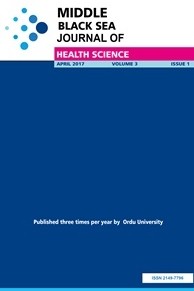Outcomes of Microsurgical Clipping in Middle Cerebral Artery Aneurysms
Objective: Surgical or endovascular treatment is used in the treatment of intracranial aneurysms. Recent studies have suggested that the of endovascular treatment are superior to surgery Middle cerebral artery (MCA) aneurysm is the third most common bleeding aneurysm after anterior communicating artery and internal carotid artery aneurysms. We aimed to retrospectively evaluate the microsurgical outcomes of cases operated for MCA aneurysm.Methods: Twenty cases with MCA aneurysm who accepted the microsurgical treatment option were included in this study. Data were obtained by retrospectively reviewing the clinical, radiological, and intraoperative findings, as well as postoperative morbidity and mortality of the cases.Results: In total, 23 MCA aneurysms were detected in 20 cases. In 2 cases, MCA aneurysm was detected incidentally. Microsurgical clipping was performed in 23 aneurysms. In the study, the total mortality rate was 10% and the morbidity rate was 20% in MCA aneurysms.Conclusion: It was observed that the incidence of calcification or thrombosis within the aneurysm increased and the Glasgow outcome scores at the 3rd month decreased as the width and length values of the aneurysm sac increased. In addition, presence of calcification in the aneurysm wall or thrombosis in the sac was found to be positive and strongly correlated with mortality and morbidity.
Keywords:
Middle cerebral artery aneurysm, microsurgery,
___
- 1. Molyneux A, Kerr R, Stratton I, Sandercock P, Clarke M, Shrimpton J, Holman R: International Subarachnoid Aneurysm Trial (ISAT) of neurosurgical clipping versus endovascular coiling in 2143 patients with ruptured intracranial aneurysms: A randomised trial. Lancet 360:1267-1274, 2002
- 2. Kahilogulları G, Bozkurt M, Egemen N Middle Cerebral Artery Aneurysms: Yesterday and Today. Turkish Neurosurgery Journal 2013, Vol: 23, Number: 1, 27-39
- 3. Matsukawa H, Kamiyama H, Miyazaki T, Kinoshita Y, Ota N, Noda K, Shonai T, Takahashi O, Tokuda S, Tanikawa R. Surgical Treatment of Middle Cerebral Artery Aneurysms: Aneurysm Location and Size Ratio as Risk Factors for Neurologic Worsening and Ischemic Complications. World Neurosurg. 2018;117:e563-e570. doi: 10.1016/j.wneu.2018.06.077
- 4. Rodríguez-Hernández A, Sughrue ME, Akhavan S, Habdank-Kolaczkowski J, Lawton MT. Current management of middle cerebral artery aneurysms: surgical results with a "clip first" policy. Neurosurgery. 2013;72(3):415-27.
- 5. Elsharkawy A, Lehečka M, Niemelä M, Kivelev J, Billon-Grand R, Lehto H, et. al. Anatomic risk factors for middle cerebral artery aneurysm rupture: computed tomography angiography study of 1009 consecutive patients. Neurosurgery. 2013;73(5):825-37; discussion 836-7
- 6. Hallout S. Surgical Treatment of Middle Cerebral Artery Aneurysms Without Using Indocyanine Green Videoangiography Assistance: Retrospective Monocentric Study of 263 Clipped Aneurysms. World Neurosurg. 2015;84(4):972-7.
- 7. Morgan MK, Mahattanakul W, Davidson A, Reid J. Outcome for middle cerebral artery aneurysm surgery. Neurosurgery. 2010; 67(3):755-61
- 8. Ulutas M. Intracranial aneurysm surgery outcomes: a single Center experience. Cukurova Med J 2016;41(4):732-743
- 9. Flamm ES, Grigorian AA, Marcovici A Multifactorial analysis of surgical outcome in patients with unruptured middle cerebral artery aneurysms. Ann Surg 2000;232:570–575 10. Washington CW, Ju T, Zipfel GJ, Dacey RG Jr. Middle cerebral artery bifurcation aneurysms: an anatomic classification scheme for planning optimal surgical strategies. Neurosurgery. 2014 Mar;10 Suppl 1:145-53; discussion 153-5
- 11. Mooney MA, Simon ED, Brigeman S, Nakaji P, Zabramski JM, Lawton MT, et. al. Long-term results of middle cerebral artery aneurysm clipping in the Barrow Ruptured Aneurysm Trial. J Neurosurg. 2018;130(3):895-901. doi: 10.3171/2017.10.JNS172183.
- 12. Ryu DS, Shim YS: Importance of hematoma removal ratio in ruptured middle cerebral artery aneurysm surgery with intrasylvian hematoma. J Cerebrovasc Endovasc Neurosurg 19:5–11, 2017
- Yayın Aralığı: Yılda 4 Sayı
- Başlangıç: 2015
- Yayıncı: Ordu Üniversitesi
Sayıdaki Diğer Makaleler
Barış HEKİMOĞLU, Muhammet Ali BEYOĞLU, Mehmet ŞAHİN
Deniz DENİZ ÖZTURAN, Figen ÜNAL DEMİR
Zeynep KÜÇÜKAKÇALI, İpek BALIKÇI ÇİÇEK
Çiğdem GÜLER, Nihal BELDÜZ KARA, Didem TÜRKEN
Kübra GÖKALP, Mevra AYDIN ÇİL, Ayşegül YAYLA
Gulhan KURTOGLU CELİK, Gül PAMUKÇU GÜNAYDIN, Çağdaş YILDIRIM, Şervan GÖKHAN
